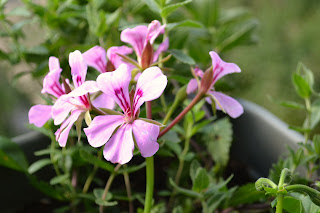
This entry follows up on my showcase of the many purple flowers residing in my garden. This week's entry focuses on the lighter "purples" (from basic purple to violet to light blue). From dark to light, this set includes: clematis, lisianthus, salvia, plumbago and silver petunia.
The "Light" Purples
I've classified this set as "lighter" purple because of the way their petals lighten as they age. Unlike the "true" purples showcased in the last entry, these flowers start out purple, but lighten to a lavender-esque shade as they finish blooming. Among this group, from dark to light, we have: clematis, lisianthus and silver petunia.
Clematis - This year's clematis has been much more successful than last year's attempts. While this variety only bloomed in June, it produced spectacular purple flowers that looked great on the climbing trellis I planted in their container. Clematis are categorized according to whether the new flowers bloom only on new growth, old growth or both year to year. I'm not sure what kind I have, but, hopefully, I will get to find out next year.

Lisianthus - a native prairie flower also known as eustoma. I hope to have a separate entry on it sometime soon.

Silver Petunia - these are a repeat from last year. I just love the delicate coloring that appears almost fuschia in the center and fades to a silverly purple. The photos just can't capture this spectacular coloring, but if you ever see one in your garden store, I highly recommend it!

The "Light" Blues
The flowers in this group look even more blue than their blue-purple cousins. These flowers have cooler notes of light blue petals, ranging from a robin's egg blue to a very light blue. In my garden, this group is represented by the salvia and the plumbago.
Salvia - one of the first plants in this year's garden. Salvia is actually a sage variety that produces small bright blue flowers. Mine is somewhat temperamental and looks kind of dead half of the time, but blooms the other half - I think it depends on whether it is too hot or not.

Plumbago - one of the showier residents of the garden. This trailer produces wonderfully delicate light blue blooms in large heads with individual flowers (similar to a geranium). My only complaint is that it is very sticky, making it hard to dead head.



















